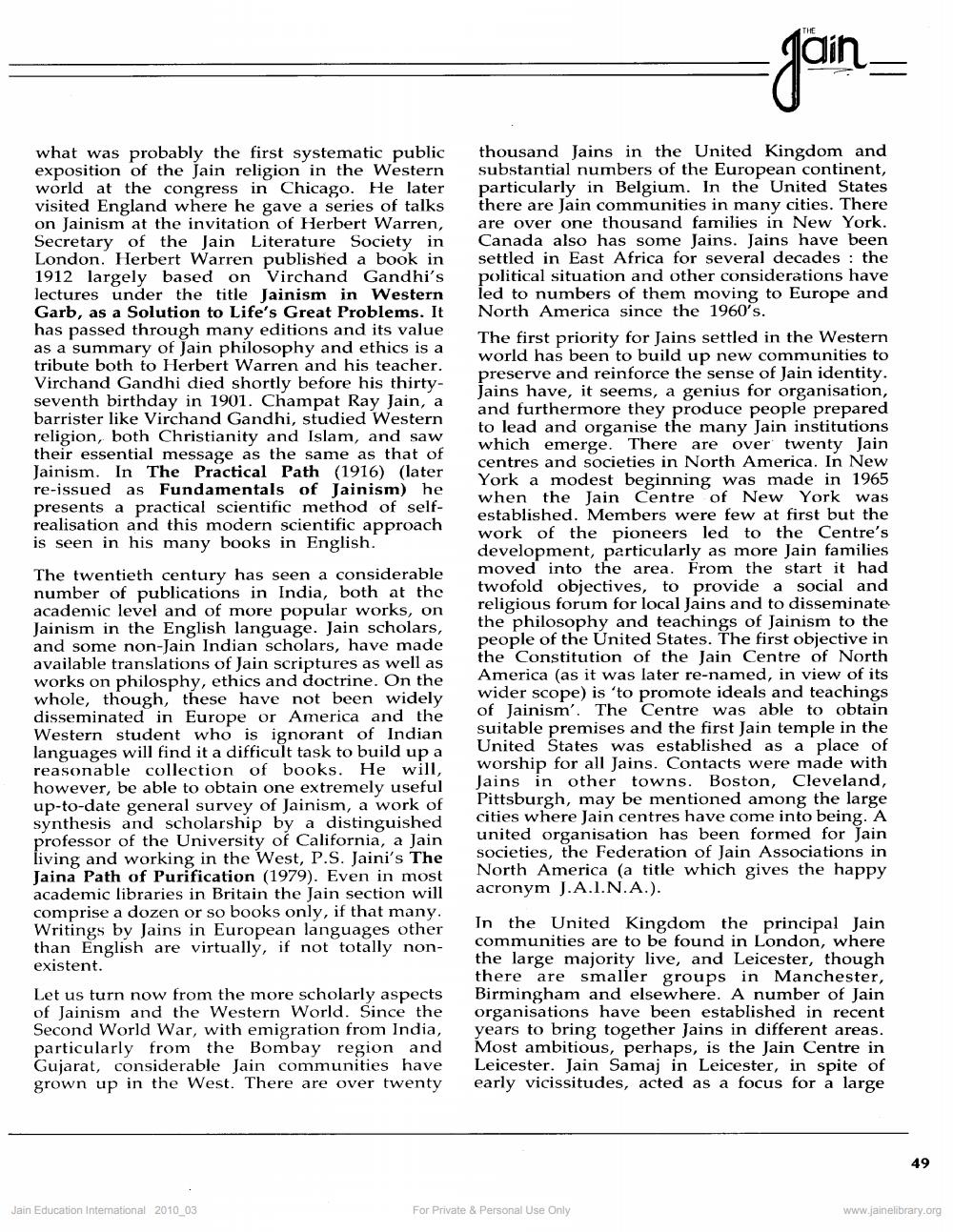________________
what was probably the first systematic public exposition of the Jain religion in the Western world at the congress in Chicago. He later visited England where he gave a series of talks on Jainism at the invitation of Herbert Warren, Secretary of the Jain Literature Society in London. Herbert Warren published a book in 1912 largely based on Virchand Gandhi's lectures under the title Jainism in Western Garb, as a Solution to Life's Great Problems. It has passed through many editions and its value as a summary of Jain philosophy and ethics is a tribute both to Herbert Warren and his teacher. Virchand Gandhi died shortly before his thirtyseventh birthday in 1901. Champat Ray Jain, a barrister like Virchand Gandhi, studied Western religion, both Christianity and Islam, and saw their essential message as the same as that of Jainism. In The Practical Path (1916) (later re-issued as Fundamentals of Jainism) he presents a practical scientific method of selfrealisation and this modern scientific approach is seen in his many books in English.
The twentieth century has seen a considerable number of publications in India, both at the academic level and of more popular works, on Jainism in the English language. Jain scholars, and some non-Jain Indian scholars, have made available translations of Jain scriptures as well as works on philosphy, ethics and doctrine. On the whole, though, these have not been widely disseminated in Europe or America and the Western student who is ignorant of Indian languages will find it a difficult task to build up a reasonable collection of books. He will, however, be able to obtain one extremely useful up-to-date general survey of Jainism, a work of synthesis and scholarship by a distinguished professor of the University of California, a Jain living and working in the West, P.S. Jaini's The Jaina Path of Purification (1979). Even in most academic libraries in Britain the Jain section will comprise a dozen or so books only, if that many. Writings by Jains in European languages other than English are virtually, if not totally nonexistent.
Let us turn now from the more scholarly aspects of Jainism and the Western World. Since the Second World War, with emigration from India, particularly from the Bombay region and Gujarat, considerable Jain communities have grown up in the West. There are over twenty
Jain Education International 2010_03
THE
=Jain_
thousand Jains in the United Kingdom and substantial numbers of the European continent, particularly in Belgium. In the United States there are Jain communities in many cities. There are over one thousand families in New York. Canada also has some Jains. Jains have been settled in East Africa for several decades: the political situation and other considerations have led to numbers of them moving to Europe and North America since the 1960's.
The first priority for Jains settled in the Western world has been to build up new communities to preserve and reinforce the sense of Jain identity. Jains have, it seems, a genius for organisation, and furthermore they produce people prepared to lead and organise the many Jain institutions which emerge. There are over twenty Jain centres and societies in North America. In New York a modest beginning was made in 1965 when the Jain Centre of New York was established. Members were few at first but the
work of the pioneers led to the Centre's development, particularly as more Jain families moved into the area. From the start it had twofold objectives, to provide a social and religious forum for local Jains and to disseminate the philosophy and teachings of Jainism to the people of the United States. The first objective in the Constitution of the Jain Centre of North America (as it was later re-named, in view of its wider scope) is 'to promote ideals and teachings of Jainism'. The Centre was able to obtain suitable premises and the first Jain temple in the United States was established as a place of worship for all Jains. Contacts were made with Jains in other towns. Boston, Cleveland, Pittsburgh, may be mentioned among the large cities where Jain centres have come into being. A united organisation has been formed for Jain societies, the Federation of Jain Associations in North America (a title which gives the happy acronym J.A.1.N.A.).
In the United Kingdom the principal Jain communities are to be found in London, where the large majority live, and Leicester, though there are smaller groups in Manchester, Birmingham and elsewhere. A number of Jain organisations have been established in recent years to bring together Jains in different areas. Most ambitious, perhaps, is the Jain Centre in Leicester. Jain Samaj in Leicester, in spite of early vicissitudes, acted as a focus for a large
For Private & Personal Use Only
49
www.jainelibrary.org




